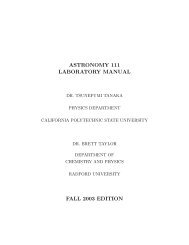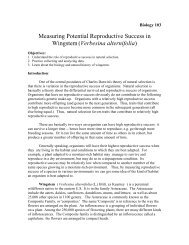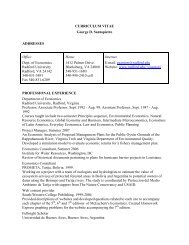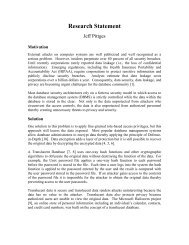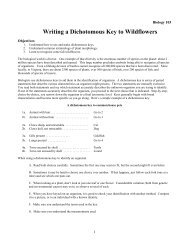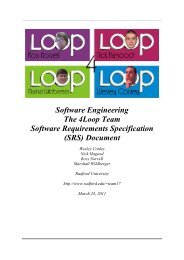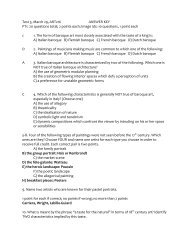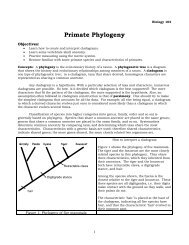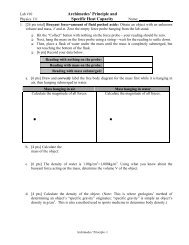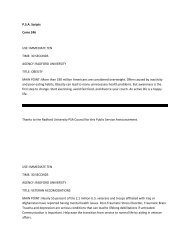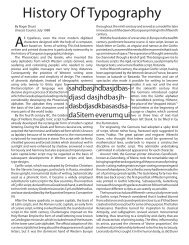Parallel Lines Cut by a Transversal
Parallel Lines Cut by a Transversal
Parallel Lines Cut by a Transversal
You also want an ePaper? Increase the reach of your titles
YUMPU automatically turns print PDFs into web optimized ePapers that Google loves.
<strong>Parallel</strong> <strong>Lines</strong> <strong>Cut</strong> <strong>by</strong> a <strong>Transversal</strong><br />
I. UNIT OVERVIEW & PURPOSE:<br />
The goal of this unit is for students to understand the angle theorems related to parallel<br />
lines. This is important not only for the mathematics course, but also in connection to<br />
the real world as parallel lines are used in designing buildings, airport runways, roads,<br />
railroad tracks, bridges, and so much more. Students will work cooperatively in groups<br />
to apply the angle theorems to prove lines parallel, to practice geometric proof and<br />
discover the connections to other topics including relationships with triangles and<br />
geometric constructions.<br />
II. UNIT AUTHOR:<br />
Darlene Walstrum<br />
Patrick Henry High School<br />
Roanoke City Public Schools<br />
III. COURSE:<br />
Mathematical Modeling: Capstone Course<br />
IV. CONTENT STRAND:<br />
Geometry<br />
V. OBJECTIVES:<br />
1. Using prior knowledge of the properties of parallel lines, students will identify and<br />
use angles formed <strong>by</strong> two parallel lines and a transversal. These will include<br />
alternate interior angles, alternate exterior angles, vertical angles, corresponding<br />
angles, same side interior angles, same side exterior angles, and linear pairs.<br />
2. Using the properties of these angles, students will determine whether two lines are<br />
parallel.<br />
3. Students will verify parallelism using both algebraic and coordinate methods.<br />
4. Students will practice geometric proof.<br />
5. Students will use constructions to model knowledge of parallel lines cut <strong>by</strong> a<br />
transversal. These will include the following constructions: parallel lines,<br />
perpendicular bisector, and equilateral triangle.<br />
6. Students will work cooperatively in groups of 2 or 3.<br />
VI. MATHEMATICS PERFORMANCE EXPECTATION(s):<br />
MPE.32 The student will use the relationships between angles formed <strong>by</strong> two lines cut<br />
<strong>by</strong> a transversal to<br />
a) determine whether two lines are parallel;<br />
b) verify the parallelism, using algebraic and coordinate methods as well as<br />
deductive proofs; and<br />
c) solve real-world problems involving angles formed when parallel lines are cut <strong>by</strong><br />
a transversal.<br />
VII. CONTENT:<br />
Students will use prior knowledge of parallel lines cut <strong>by</strong> a transversal and geometric<br />
constructions to create a map to given specifications. The map will be a representation<br />
of a small section of a city or town and will serve to introduce students to the usefulness
of mathematics in a different context. This project will encourage students to work<br />
cooperatively and to see how these concepts are used in the real world.<br />
VIII. REFERENCE/RESOURCE MATERIALS:<br />
SMART Board, document camera, or LCD projector for modeling, markers, calculators,<br />
rulers, compasses, poster boards, and the following handouts:<br />
Pre-Assessment (Attached)<br />
Construction worksheets (Attached)<br />
Lesson 2 homework (Attached)<br />
Directions for map construction (Attached)<br />
Solution for map construction (Attached)<br />
IX. PRIMARY ASSESSMENT STRATEGIES:<br />
Attached for each lesson. Students will be given a pre-assessment in the form of a<br />
handout to assess prior knowledge at the beginning of the unit. The teacher will<br />
observe students as they work on tasks to see if and where any additional help may be<br />
needed. Teacher will also monitor, observe, and communicate with students as they<br />
work in groups. Homework assignments will be given after each lesson. The homework<br />
will be discussed with the class and graded <strong>by</strong> the instructor. The final assessment will<br />
be the completed project.<br />
X. EVALUATION CRITERIA:<br />
Attached for each lesson. Students will be observed as they work during class. Whole<br />
class discussions will also help the instructor to determine student knowledge. Students<br />
will check each others’ work throughout the unit. Presentations <strong>by</strong> the students and<br />
feedback from their peers will also serve as an evaluation tool. The final assessment will<br />
consist of the construction of a map and problems regarding parallel lines from the map.<br />
XI. INSTRUCTIONAL TIME:<br />
The unit should take a total of three days of block scheduling, six days if standard.
LESSON 1: PARALLEL LINES & CONSTRUCTIONS<br />
STRAND: Geometry<br />
MATHEMATICAL OBJECTIVES:<br />
To review and practice geometric constructions.<br />
To review and practice concepts regarding parallel lines cut <strong>by</strong> a transversal.<br />
To determine whether two lines are parallel.<br />
To encourage working cooperatively in small groups.<br />
Recognize properties of parallel lines outside of the classroom.<br />
MATHEMATICS PERFORMANCE EXPECTATIONS:<br />
MPE 32.a The student will use the relationships between angles formed <strong>by</strong> two lines cut<br />
<strong>by</strong> a transversal to determine whether two lines are parallel.<br />
VIRGINIA SOL: G.2a, G.4 c, f, g<br />
‣ The student will use the relationships between angles formed <strong>by</strong> two lines cut <strong>by</strong> a<br />
transversal to determine whether two lines are parallel.<br />
‣ The student will construct and justify the constructions of:<br />
A perpendicular to a given line from a point not on the line.<br />
An angle congruent to a given angle.<br />
A line parallel to a given line through a point not on the given line.<br />
NCTM STANDARDS:<br />
Use geometric models to gain insights into, and answer questions in, other areas of<br />
mathematics.<br />
Use geometric ideas to solve problems in, and gain insights into, other disciplines and<br />
other areas of interest such as art and architecture.<br />
Explore relationships among classes of two-dimensional geometric objects, make and<br />
test conjectures about them, and solve problems involving them.<br />
Draw and construct representations of two- and three-dimensional geometric objects<br />
using a variety of tools.<br />
MATERIALS/RESOURCES: Classroom set of calculators, SMART Board or document camera to<br />
model constructions for students, rulers, compasses, and the following handouts: preassessment,<br />
and construction guides.<br />
ASSUMPTION OF PRIOR KNOWLEDGE:<br />
The student should have already completed the Geometry course offered at his/her<br />
school.<br />
Students should understand the concepts and properties of parallel lines cut <strong>by</strong> a<br />
transversal.
Students should be able to accurately construct a pair of parallel lines, a perpendicular<br />
bisector and an equilateral triangle.<br />
Students may have difficulty recalling vocabulary.<br />
LESSON OUTLINE:<br />
I. Introduction: Review parallel lines cut <strong>by</strong> a transversal. (20 –30 minutes)<br />
A. Explain to the class they will be working on a project involving parallel lines cut<br />
<strong>by</strong> a transversal and their related angles.<br />
B. Ask students to sketch a pair of parallel lines cut with a transversal on a piece of<br />
paper at their desks. The instructor should sketch the same figure on the dry<br />
erase board at the front of the class or using a document camera. Have students<br />
mark the angles 1 – 8.<br />
C. Review the following vocabulary terms encouraging students to offer their own<br />
definitions: (Note: do not give these definitions until after you have discussed<br />
the students’ definitions).<br />
1. <strong>Parallel</strong> lines – coplanar lines that do not intersect<br />
2. <strong>Transversal</strong> – A line that intersects two or more coplanar lines<br />
3. Alternate Interior Angles – Two nonadjacent interior angles on opposite sides<br />
of a transversal<br />
4. Alternate Exterior Angles – Two nonadjacent exterior angles on opposite<br />
sides of a transversal<br />
5. Corresponding Angles – Two nonadjacent angles on the same side of a<br />
transversal such that one is an exterior angle and the other is an interior<br />
angle.<br />
6. Vertical Angles – Two non adjacent angles formed <strong>by</strong> a pair of intersecting<br />
lines that share a vertex<br />
7. Same-side Interior Angles – Two nonadjacent angles in the same side of a<br />
transversal.<br />
8. Linear Pairs – Two adjacent angles whose measurements sum to 180<br />
degrees.<br />
D. As each vocabulary word is discussed, discuss known properties of each pair of<br />
angles. (Congruent, supplementary). Remind students to make notes on their<br />
paper if necessary. Where are these angles found in everyday life?<br />
II. Pre-assessment (20 – 30 minutes)<br />
A. In order to better understand students’ prior knowledge and skill, give each<br />
student a pre-assessment handout to be filled out individually<br />
1. Walk around the room and observe the students’ solutions as they work.<br />
2. Go over the solutions to the handout making sure to spend extra time where<br />
needed. For questions 4 - 6, incorporate a whole class discussion and have<br />
the students justify their answers.<br />
III. Review constructions (30 – 40 minutes)<br />
A. Put students into groups of 2-3 to practice constructions<br />
B. Give each student a set of the following construction handouts and a compass.<br />
1. Copy an angle
IV.<br />
2. Perpendicular bisector<br />
3. <strong>Parallel</strong> lines<br />
C. Use a SMART Board or document camera to model steps for constructions. (You<br />
may want to have a student come to the camera and model for the class).<br />
D. Let students help each other to complete the practice constructions.<br />
E. Ask students to construct an equilateral triangle.<br />
F. Observe and monitor as needed.<br />
G. Homework: Tell the students to give examples of real life models for each angle<br />
relationship. Encourage them to list several examples for each angle<br />
relationship. An example for vertical angles would be when two jet streams<br />
cross each other in the sky.<br />
Extensions and connections for all students<br />
A. For the homework assignment, ask students to name some jobs that might<br />
require a working knowledge of parallel lines cut <strong>by</strong> a transversal or<br />
constructions.<br />
V. Strategies for differentiation<br />
A. ELL and ESL students may need extra help with vocabulary. The teacher may<br />
want to explain certain terms <strong>by</strong> relating to something else, such as, interior<br />
being inside the parallel lines. You could also offer a foldable or a fill-in-theblank<br />
handout. Seating arrangements should be considered – sit the student<br />
near the teacher, or if possible, with a fellow student who speaks the same<br />
language. Dictionaries and online translators are good resources also.<br />
B. Some students may have difficulty using a protractor. For these students you<br />
may wish to offer transparency paper for the constructions
Pre-Assessment<br />
Part 1 – Use the diagram of the two parallel lines below to answer questions 1 - 3.<br />
B<br />
A<br />
C<br />
D<br />
1. A and D are called __________________ angles.<br />
2. B and D are called __________________ angles.<br />
3. C and D are called __________________ angles.<br />
Part 2 – Use the diagram below to answer questions 4 – 6.<br />
l<br />
m<br />
A B<br />
C D<br />
E F G H<br />
e<br />
J K N P<br />
Q R T W<br />
f<br />
4. Name all the angles that would be congruent to C if and only if lines e and f are<br />
parallel.<br />
5. Assume lines l and m are parallel, and lines e and f are parallel. List all the angles that<br />
would be congruent to K.<br />
6. Assume we do not know if any of the lines in the figure above are parallel. Determine<br />
which of the following angle relationships would prove lines e and f parallel. For each of<br />
the problems, explain why or why not.<br />
a) A J
) A C<br />
c) D T<br />
d) G P<br />
e) N W<br />
f) A + Q = 180°<br />
g) K + N = 180°
Pre-Assessment Answer Key<br />
Part 1 – Use the diagram of the two parallel lines below to answer questions 1 - 3.<br />
B<br />
A<br />
C<br />
D<br />
A and D are called __corresponding__angles.<br />
B and D are called _alternate interior___ angles.<br />
C and D are called _same-side interior or consecutive interior__ angles.<br />
Part 2 – Use the diagram below to answer questions 4 – 6.<br />
l<br />
m<br />
A B<br />
C D<br />
E F G H<br />
e<br />
J K N P<br />
Q R T W<br />
f<br />
4. Name all the angles that would be congruent to C if and only if lines e and f are<br />
parallel. H,<br />
5. Assume lines l and m are parallel, and lines e and f are parallel. List all the angles that<br />
would be congruent to K. Q, B, E, P, T, G, D<br />
6. Assume we do not know if any of the lines in the figure above are parallel. Determine<br />
which of the following angle relationships would prove lines e and f parallel. For each of the<br />
problems, explain why or why not.<br />
a) A J Yes, corresponding angles
) A C No, both angles on line E<br />
c) D T Yes, alternate exterior angles<br />
d) G P Yes, alternate interior angles<br />
e) N W No, both angles on line F<br />
f) A + Q = 180° Yes, same side exterior<br />
g) K + N = 180° No, both angles on line F
Constructions!<br />
Make a copy of the angle:<br />
First, make a ray that will become one of the two rays of the angle.<br />
Beginning with the vertex of the original angle, take your compass and create an arc that<br />
intersects the angle twice. The exact measurement you begin with doesn't matter. Using this<br />
same measurement, do the same thing beginning at the endpoint of the ray.<br />
Now, using your compass, set it to be the distance from one of the intersection points on the<br />
original angle to the other intersection point on the original angle.<br />
Keeping your compass on that same setting, make an arc coming from the intersection point on<br />
the ray, going up and intersecting the last arc you made on the ray.<br />
This will intersect at a point. Draw the line going from this point to the endpoint of the ray to<br />
complete the copy of the angle.
PRACTICE WITH THESE!
Constructions!<br />
Construct a perpendicular through a point not on the line:<br />
First, take your compass and make a big arc that hits the line segment twice. This will create<br />
two endpoints.<br />
From each endpoint, make an arc below the line (we already found a point above, so we don't<br />
need that one!).<br />
This will intersect at a point. Draw the line going from this point to the one we were given at<br />
first to get the perpendicular going through a point not on the line.
PRACTICE WITH THESE!<br />
.<br />
.<br />
.<br />
.<br />
.<br />
.
Constructions!<br />
Construct a parallel through a point not the line:<br />
First, create a ray from any point on the line to the point. This will form an angle.<br />
Make an arc on the angle, then use the same setting to make the same arc on the original<br />
point.<br />
Now, using your compass, set it to be the distance from one of the intersection points on the<br />
original angle to the other intersection point on the original angle.<br />
Keeping your compass on that same setting, make an arc coming from the intersection point on<br />
the ray, going down and intersecting the last arc you made on the ray.<br />
This will intersect at a point. Draw the line going from this point to the endpoint of the ray to<br />
complete the parallel line.
PRACTICE WITH THESE!<br />
.<br />
.<br />
.<br />
.<br />
.
LESSON 2: PARALLEL LINES & PROOF<br />
STRAND: Geometry<br />
MATHEMATICAL OBJECTIVES:<br />
To review and practice concepts regarding parallel lines cut <strong>by</strong> a transversal.<br />
To use algebraic methods as well as deductive proof to verify if two lines are parallel.<br />
Use two column proofs to prove parallel line theorems.<br />
To encourage working cooperatively in small groups.<br />
<br />
MATHEMATICS PERFORMANCE EXPECTATIONS:<br />
MPE 32.a, b The student will use the relationships between angles formed <strong>by</strong> two lines cut <strong>by</strong> a<br />
transversal to determine whether two lines are parallel; verify the parallelism, using algebraic<br />
and coordinate methods as well as deductive proofs.<br />
VIRGINIA SOL: G.2a-c<br />
The student will use the relationships between angles formed <strong>by</strong> two lines cut <strong>by</strong> a transversal<br />
to determine whether two lines are parallel, verify the parallelism, using algebraic and<br />
coordinate methods as well as deductive proofs, and solve real-world problems involving angles<br />
formed when parallel lines are cut <strong>by</strong> a transversal.<br />
NCTM STANDARDS:<br />
Establish the validity of geometric conjectures using deduction, prove theorems, and<br />
critique arguments made <strong>by</strong> others.<br />
Use geometric models to gain insights into, and answer questions in, other areas of<br />
mathematics.<br />
Explore relationships among classes of two-dimensional geometric objects, make and<br />
test conjectures about them, and solve problems involving them.<br />
MATERIALS/RESOURCES: Rulers, document camera or LCD projector for modeling problems<br />
and ease of viewing. If these are not available, you can always sketch the diagram on a dryerase<br />
board at the front of the classroom.<br />
LESSON OUTLINE:<br />
I. Introduction: Focus activity (15 – 20 minutes)<br />
A. Discuss answers to lesson 1 homework.<br />
B. Tell students to write down all the properties they can think of regarding two<br />
parallel lines cut <strong>by</strong> a transversal. Explain that you are looking for a summary of<br />
properties. Ask the students to complete the following statement as many times<br />
as necessary: “Two parallel lines that are cut <strong>by</strong> a transversal form ….”<br />
C. Have students share what they have written. Put these on the dry-erase board<br />
as a running list. Be sure to have students explain their reasoning whether they
II.<br />
give a correct statement or an incorrect statement. As a class, determine which<br />
of the statements are valid and should stay part of the list.<br />
1. The properties should include the following:<br />
a. Two parallel lines that are cut <strong>by</strong> a transversal form congruent alternate<br />
interior angles.<br />
b. Two parallel lines that are cut <strong>by</strong> a transversal form congruent alternate<br />
exterior angles.<br />
c. Two parallel lines that are cut <strong>by</strong> a transversal form congruent<br />
corresponding angles.<br />
d. Two parallel lines that are cut <strong>by</strong> a transversal form supplementary<br />
angles on the same side of the transversal.<br />
e. If two parallel lines are cut <strong>by</strong> a transversal, and the transversal is<br />
perpendicular to one line, then the transversal is also perpendicular to<br />
the other line.<br />
Proving lines parallel – part 1 (20 minutes)<br />
A. Introduction to proof.<br />
1. Place students in groups of three or four so they can brainstorm together.<br />
Write the following problem on the dry erase board at the front of the class.<br />
Instruct students to copy the problem onto their own paper. Each student<br />
should then find the measure of each angle asked for and state the reason<br />
why they know the measurement. Ask the students to find as many valid<br />
reasons as possible. Give an example of what you are looking for: For<br />
question 1, = 78° because and are linear pairs.<br />
K<br />
A<br />
C<br />
E G H J F<br />
M<br />
N<br />
D<br />
B<br />
Given ⃡ ⃡ , , , find the measure of each angle. Be sure<br />
to state the reason you know this. Answers are given in red; students may offer different, yet<br />
valid, reasons for the measures.<br />
1) 78 and are a linear pair<br />
2) 102 and are corresponding angles<br />
3) 78 and are corresponding angles<br />
L
4) 102 and are vertical angles<br />
5) 45 and are a linear pair<br />
6) 135 and are vertical angles<br />
7) 135 and are corresponding angles<br />
8) 45 and are linear pairs<br />
9) 33 triangle sum conjecture<br />
10) 33 and are vertical angles<br />
a. When going over the solutions and explanations to these problems,<br />
students may offer solutions before it is valid to do so. Remind students<br />
that even though they may “know” the measure of an angle, in order to<br />
give that measure, they must have a valid explanation.<br />
b. Discuss solutions one at a time with the class. Let the students<br />
determine <strong>by</strong> discussion which solutions are correct and valid.<br />
c. When going over problem 9 ask students if anyone solved the problem<br />
using the triangle sum conjecture. Lead this into a discussion of what is<br />
known about triangles GJN and HJM. (They are similar). How do we<br />
know this?<br />
d. When going over problem 10, if no student offers this as a manner of<br />
solving the problem, discuss the exterior angle of a triangle theorem.<br />
B. Proving lines parallel. (45 – 60 minutes)<br />
1. Discuss with students that they already have all the knowledge necessary,<br />
(the properties discussed in the focus activity and from the exercise above),<br />
to prove two lines cut <strong>by</strong> a transversal are parallel. Tell students they will<br />
spend the next part of class proving this concept.<br />
a. Give the students the following postulates. Explain that they will use<br />
these postulates and several of the properties of parallel lines to prove<br />
several theorems.<br />
i. Corresponding Angles Postulate: If two coplanar lines are cut <strong>by</strong><br />
a transversal so that two corresponding angles have the same<br />
measure, then those lines are parallel.<br />
ii. <strong>Parallel</strong> <strong>Lines</strong> Postulate: If two coplanar lines are parallel and<br />
are cut <strong>by</strong> a transversal, corresponding angles have the same<br />
measure.
2. Write the following problem on the dry erase board at the front of the class<br />
and ask each student to copy. Go through the proof one step at a time<br />
asking students what they know that can help us.<br />
a. A road crosses a set of railroad tracks.<br />
If the measure of angle 5 is 106°,<br />
E<br />
find the measure of angle 4.<br />
1 2 B<br />
A 3 4<br />
5 6 D<br />
C 7 8<br />
What do we know; that is, what are we given? (<strong>Lines</strong> AB and CD are parallel and angle 5<br />
measures 106°).<br />
What are we trying to find? (The measure of angle 4). What do we know to get us there?<br />
(Since angles 1 and 5 are corresponding, we know angles 1 and 5 are congruent. Also, angles 1<br />
and 4 are congruent because they are vertical angles. Therefore, angles 4 and 5 are congruent<br />
<strong>by</strong> the transitive property of equality. Thus, the measure of angle 4 is 106°).<br />
Which theorem does this prove? (Alternate Interior Angles).<br />
b) Use this exercise to prove the Alternate Interior Angles Theorem with the<br />
class: (Only give the left side of the table. Fill in the right side with students’<br />
responses).<br />
Alternate Interior Angle Theorem – If two coplanar parallel lines are cut <strong>by</strong> a<br />
transversal, then each pair of alternate interior angles is congruent.<br />
Statement<br />
Reason<br />
⃡ ⃡ Given<br />
1 5 Corresponding angles<br />
1 4 Vertical angles<br />
4 5 Transitive property<br />
3. Copy the following problems on the dry erase board at the front of the class,<br />
(or use a document camera), and tell the students to work together to<br />
construct each proof. Encourage students to talk with each other to discover<br />
different ways of approaching the problems. Teacher should observe and<br />
monitor throughout assignment. Use the diagram from Section II, B, 2. I<br />
have included solutions in red – keep in mind these are not the only valid<br />
solutions.<br />
F
a. Alternate Exterior Angle Theorem – If two coplanar parallel lines are cut<br />
<strong>by</strong> a transversal, then each pair of alternate exterior angles is congruent.<br />
Statement<br />
Reason<br />
⃡ ⃡ Given<br />
1 5 Corresponding angles<br />
5 8 Vertical angles<br />
1 8 Transitive property<br />
b. Same Side Interior Angle Theorem – If two coplanar parallel lines are cut<br />
<strong>by</strong> a transversal, then each pair of same side, or consecutive, angles is<br />
supplementary.<br />
Statement<br />
Reason<br />
⃡ ⃡ Given<br />
1 + 3 = 180° Linear Pairs<br />
1 5 Corresponding angles<br />
3 + 5 = 180° Substitution<br />
c. Perpendicular <strong>Transversal</strong> Theorem – In a plane, if two lines are each<br />
perpendicular to the same line, then they are parallel.<br />
Statement<br />
Reason<br />
⃡ ⃡ ⃡ ⃡ Given<br />
1 5 Corresponding angles<br />
1 4 Vertical angles<br />
4 5 Transitive property<br />
⃡ ⃡ Alternate Interior angles theorem<br />
III.<br />
IV.<br />
C. Summary/Homework –<br />
1. Discuss the solutions with the class after they have completed the proofs.<br />
Note that not all students will construct the same proof. Be sure to take the<br />
time to discuss different proofs and their validity so students will understand<br />
there is not just one correct answer.<br />
2. Homework: Handout, Lesson 2<br />
Extensions and connections for all students<br />
A. Ask students to write a journal entry explaining why learning how to write a<br />
proof would be helpful in ways beyond mathematics.<br />
Strategies for differentiation<br />
A. Students may have trouble setting up the proofs. For those having a particularly<br />
difficult time, tell them to break the problem down into what they know and<br />
what they need to know. It may be easier for some students to create a more<br />
informal proof – a paragraph proof where they simply explain what they know<br />
and how to get to where they know.
Lesson 2 Homework<br />
Refer to the diagram to the right for the following exercises.<br />
Write your answers in complete sentences.<br />
E<br />
1 2 B<br />
A 3 4<br />
5 6 D<br />
C 7 8<br />
1. If the = 4x + 18 and = 6x + 2, F<br />
Find the measure of x that proves ⃡ ⃡ .<br />
Explain why your solution is valid.<br />
2. If the = 3x + 5 and = 4x – 22,<br />
Find the measure of x that proves ⃡ ⃡ .<br />
Explain why your solution is valid.<br />
3. ⃡ intersects ⃡ and ⃡ . and are supplements.<br />
Prove ⃡ ⃡ .
Lesson 2 Homework – Answer Key<br />
Refer to the diagram to the right for the following exercises.<br />
Write your answers in complete sentences.<br />
E<br />
1 2 B<br />
A 3 4<br />
5 6 D<br />
C 7 8<br />
1. If the = 4x + 18 and = 6x + 2, F<br />
Find the measure of x that proves ⃡ ⃡ .<br />
Explain why your solution is valid.<br />
Angles 3 and 5 are same side interior angles. Same side interior angles in parallel lines are<br />
supplementary. This means if ⃡ ⃡ , then 4x + 18 + 6x + 2 = 180. Then, x = 16°.<br />
2. If the = 3x + 5 and = 4x – 22,<br />
Find the measure of x that proves ⃡ ⃡ .<br />
Explain why your solution is valid.<br />
Angles 1 and 8 are alternate exterior angles. Alternate exterior angles are congruent. This<br />
means if ⃡ ⃡ , then 3x + 5 = 4x – 22 . Then, x = 27°.<br />
3. ⃡ intersects ⃡ and ⃡ . and are supplements.<br />
Prove ⃡ ⃡ .<br />
If and are supplements, then their sum is 180°. By the same side interior angles<br />
theorem, ⃡ ⃡ .<br />
You will probably want students to write a lot more than this since proving the parallel line<br />
theorems is still fairly new to them. Encourage your students to write as much as they feel<br />
is necessary to prove the statements.
LESSON 3: CREATE A MAP<br />
STRAND: Geometry<br />
MATHEMATICAL OBJECTIVES:<br />
To construct parallel and perpendicular lines, construct an equilateral triangle.<br />
To solve problems regarding parallel lines cut <strong>by</strong> a transversal.<br />
To determine whether two lines are parallel.<br />
To use algebraic methods as well as deductive proof to verify if two lines are parallel.<br />
To encourage working cooperatively in small groups.<br />
MATHEMATICS PERFORMANCE EXPECTATIONS:<br />
MPE 32.a, b. The student will use the relationships between angles formed <strong>by</strong> two lines cut <strong>by</strong><br />
a transversal to determine whether two lines are parallel; verify the parallelism, using algebraic<br />
and coordinate methods as well as deductive proofs.<br />
VIRGINIA SOL: G.2a-c, G.4 c, f, g<br />
‣ The student will use the relationships between angles formed <strong>by</strong> two lines cut <strong>by</strong> a<br />
transversal to determine whether two lines are parallel, verify the parallelism, using<br />
algebraic and coordinate methods as well as deductive proofs, and solve real-world<br />
problems involving angles formed when parallel lines are cut <strong>by</strong> a transversal.<br />
‣ The student will construct and justify the constructions of:<br />
A perpendicular to a given line from a point not on the line.<br />
An angle congruent to a given angle.<br />
A line parallel to a given line through a point not on the given line.<br />
NCTM STANDARDS:<br />
Use geometric models to gain insights into, and answer questions in, other areas of<br />
mathematics.<br />
Use geometric ideas to solve problems in, and gain insights into, other disciplines and<br />
other areas of interest such as art and architecture.<br />
Explore relationships among classes of two-dimensional geometric objects, make and<br />
test conjectures about them, and solve problems involving them.<br />
Draw and construct representations of two- and three-dimensional geometric objects<br />
using a variety of tools.<br />
Establish the validity of geometric conjectures using deduction, prove theorems, and<br />
critique arguments made <strong>by</strong> others.<br />
MATERIALS/RESOURCES: Classroom set of calculators, pencils, markers, rulers, compasses, and<br />
poster board.
LESSON OUTLINE:<br />
I. Introduction: Go over previous lesson’s homework. (20 –30 minutes)<br />
A. Put students back into groups of three or four and ask them to critique each<br />
other’s group. Which proofs are valid? Which are not? Why or why not? What<br />
could you change to “fix” the proof?<br />
B. Ask each group to share a problem with the class. A student should come to the<br />
front of the class and model/discuss with the rest of the class. Stress that a<br />
problem does not have to be done correctly to be worthy of discussion. It would<br />
be beneficial if each group shows a proof done differently from those already<br />
discussed.<br />
II. Construction of map (20 – 30 minutes)<br />
A. Keeping students in their groups, tell students they will create a map given the<br />
following criteria. (Directions for map construction attached). Each student<br />
should create their own map on a piece of poster board though discussion<br />
throughout the group is encouraged. When first considering the directions for<br />
the map, students should sketch the design somewhere other than the poster<br />
board to be certain they know what their goal is before they begin constructions.<br />
Tell students to do all constructions in pencil. Once they are happy with all the<br />
constructions and their labeling, they should then use a marker to highlight only<br />
the streets and labels to try and take the focus away from the constructions. Do<br />
not erase the constructions so these can be verified <strong>by</strong> the instructor.<br />
1. The teacher should observe and monitor students as they work. Encourage<br />
students to rely on each other for help and confirmation.<br />
2. As students complete their maps, have the students’ in the same groups<br />
check each others’ work.<br />
3. A copy of completed map is included as an attachment,<br />
B. Assessment of concepts (30 – 40 minutes)<br />
C. Students should work on the assessment individually.<br />
D. <strong>Parallel</strong> lines assessment attached.<br />
E. The teacher should discuss the various solutions to the assessment during the<br />
next class period.<br />
III. Extensions and connections for all students<br />
A. Ask students to write two questions concerning the map or an addition to the<br />
map. These should be thoughtful questions and should include solutions.<br />
IV. Strategies for differentiation<br />
A. Students may have difficulty using the protractors. You should have a couple of<br />
different types of protractors available if possible – traditional protractors and<br />
safety protractors.
Directions for Map Construction:<br />
Note* All streets, (lines), constructed should be extended to “run off” the poster board.<br />
1. Begin <strong>by</strong> sketching a compass to indicate the directions north, south, east and west.<br />
Draw this in the upper left hand corner of the poster board.<br />
2. Construct an equilateral triangle in the center of your poster board so that it is sitting in<br />
a standard position: . The sides of the triangle should each measure 4 inches. Use a<br />
straightedge to extend the lengths of each of the sides. Label the vertices beginning at<br />
the top of the triangle in a clockwise direction A, B, and C, respectively. This will give<br />
you three streets: AB, BC and CA.<br />
3. Construct a street parallel to street BC. Name this street AD.<br />
4. Construct street perpendicular to street AD so that it lies to the east of the triangle but<br />
does not pass through triangle ABC. Label the intersection of the perpendicular and<br />
street AD as point E. Label the intersection of the perpendicular street and street CB as<br />
point F.<br />
5. Label the intersection of streets AB and EF point G.<br />
6. Construct a street perpendicular to street CB so that it lies to the east of street EF. Label<br />
the intersection of this perpendicular and street AD as point H. Label the intersection of<br />
the perpendicular and street CB as point J.<br />
7. Label the intersection of streets AB and HJ point K.
<strong>Parallel</strong> <strong>Lines</strong> Assessment<br />
Directions: Answer each question with a complete sentence. When asked to explain,<br />
prove or disprove, answer in as many ways as you find valid using the properties of<br />
parallel lines cut <strong>by</strong> a transversal.<br />
1.<br />
2.<br />
3.<br />
a) What is the measure of BAC? Explain how you know.<br />
b) What is the measure of DAB? Explain how you know.<br />
c) What is the measure of ABF? Explain how you know.<br />
d) What is the measure of BKJ? Explain how you know.<br />
e) What is the measure of BGF? Explain how you know.<br />
a) Are streets AD and CB parallel?<br />
b) What does it mean for them to be parallel?<br />
c) Which pairs of angles could you use to prove them parallel? Give an explanation<br />
for each pair of angles you claim would prove the two streets parallel.<br />
a) Are there any other pairs of streets that are parallel?<br />
b) Why or why not?<br />
c) Use properties of angles and parallel lines to prove or disprove.<br />
4. Write a proof to explain why EAC + ACB = 180°.<br />
5. Imagine the section of the city depicted <strong>by</strong> your map has a subway that runs<br />
entirely underground and directly beneath street EF.<br />
a) Is the subway parallel to street EF? Explain.<br />
b) Is the subway parallel to another street? Explain.<br />
c) Is the subway parallel to more than one street? Explain.<br />
d) Since the subway runs underneath the streets on the map, it will never intersect<br />
with any of the streets shown on the map. Does this mean the subway is parallel<br />
to some or all of these streets? Why or why not? Explain.



